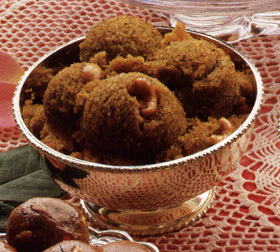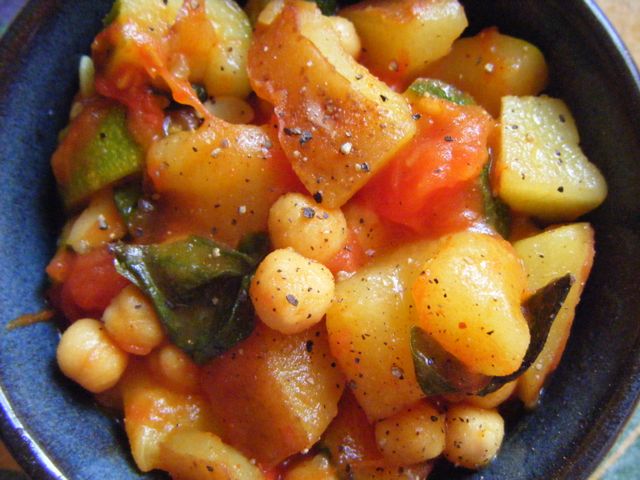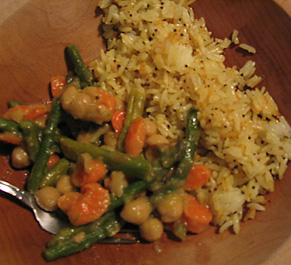Green Philosophy: Bhakti
When our spiritual teacher, A.C. Bhaktivedanta Swami Prabhupada, explained the philosophy of Bhakti Yoga to all of us students in the 1960s-70s there was already a small ecology movement in this country.
BG Garuda
Tomato, Potato, Zucchini Stew
Ingredients
- 4-6 potatoes (more if medium sized, less if big) cut into 1 inch pieces
- 1 large zucchini cut into half inch thick pieces. If the zuke is big in diameter you can cut those large rounds in half, to make half-rounds.
- 4-5 good-sized whole tomatoes, nice and ripe cut in quarters
- (if they aren’t real ripe when you buy them, let them sit outside the refrigerator for a couple days until they are nice and red)
- 10 or so fresh basil leaves, chopped if real large
- 2 Tablespoons Olive Oil or ghee*
- 1/4 teaspoon Turmeric** (optional)
- salt, pepper to taste
- hing to taste*** (optional)
- 1 can chickpeas with liquid (optional)
Procedure
Steam the potatoes in water until they are tender but not mushy. Add the zucchini on top and let that steam a minute or two until it shows that it is at least partially cooked. Drain and set aside.
In a stock pot, put olive oil or ghee. add turmeric and a dash of hing. Drop in quartered tomatoes. Unless you have gone to the trouble to remove the skins, they will be in the dish. However, once the tomatoes break down, the skins are easy to find and pull out. They aren’t bad for you, so you could leave them in also. Mash the tomatoes a little and let them cook down until you have some tomato pulp and lots of juice. Add the zuchinni and potatoes. Add the chick peas (if you are adding them) and basil at this point.
Let them simmer in the tomato for about 15 minutes. Salt and pepper to taste. If you are adding hing, just sprinkle a little across the pot.
Serve alone in a soup bowl, or over rice. Good with a fresh Greek salad and Italian bread. Very simple and elegant.
* If you use Olive oil, but want a buttery taste in the dish, add a TBs of butter near the end before you serve.
**Turmeric gives the dish a warm golden tint and turmeric is a blood purifier. Very good for you, but slightly bitter-tasting, so don’t use a lot.
***Hing is also called Asafoetida. It gives dishes a slight onion and garlic-like aroma and taste. http://en.wikipedia.org/wiki/Asafoetida
Monkey Noise
Mantra meditation without the brain’s “monkey noise”
“…As far as the Mahamantra goes, I have indeed found time to chant. I set aside an hour of time two nights ago to get as deep into the chant as possible, and it just didn’t work out. I find it intensely difficult to get past the chatter, the constant ‘monkey noise’ buzzing about in the brain.”
RESPONSE
Your dive into the Mahamantra, and the results, were interesting. It was a good experiment but, frankly, not the best way to proceed. Taking an hour and expecting to be able to chant peacefully and deeply is a bit like trying to run a marathon after only jogging a mile a few times! Or trying to lift your weight with barbells without working up to it.
My suggestion is this: First see how many rounds on the beads you can chant before your mind really rebels—then stop. Was it one, two, four rounds? Then start by chanting just that many. Of course you can chant other times too, like when walking somewhere, or standing in the grocery line, or singing while driving, etc., but I am speaking about chanting as a meditation on japa beads. Let’s say it was 2 rounds (maybe 12 minutes or so). So chant two rounds until you have no problem controlling the mind. If the mind wanders, pull it back. Focus on the chant. When you can do that easily, add a round. Eventually you can add more than one round at a time because there is a point where you have much more mind control than at first.
Some buddhists smack those in meditation with a stick when they appear to have lost focus. You don’t have to do that, just pull the mind back take a deep breath and continue. Train the mind patiently, as you would train a child. In this culture, there is little attempt to control the mind. In fact, often the opposite is true. And if you talk about restricting sense enjoyment, people gasp. They think you are taking away your freedom. They do not understand that real freedom comes ONLY with the ability to control the senses and the mind.
Each year one of the classes we give is on the hierarchy of our faculties. We’re been drawn into the world of the senses. The senses are out there roaming, constantly looking for something to focus on and become absorbed by. If you walk down a city street, you are pulled into what you see, smell, hear, etc. They are always roaming. Bhagavad-gita says that if the mind gets snared by even ONE sense, that sense can/will (if you allow it) throw off your consciousness. So the senses are always vying for your attention. They are begging the mind, “Let me eat this, smell that, feel that, etc.” It is the task of the intelligence to control the mind, or else the senses will control it. So when the intelligence controls the mind—once we are seasoned by the yogic path—the senses willingly tag along with the mind, instead of pulling it. And since the mind is more peaceful, the intelligence can be heard clearly. The intelligence is, in turn, guided by the practice of Bhakti, and so it then acts in your (the atma’s) best interest—instead of being dragged about by all the lower faculties.
Have you ever seen The Dog Whisperer? He teaches that if you have a dog, you have to be the “pack leader.” I imagine you’ve seen people in your neighborhood out walking dogs, but really the dogs are walking them—pulling them along, stopping, straining on their leash. Clearly, the dog is in control. But if you become the pack leader to your dog, then he happily trots along with you. He doesn’t at all resent that he is not leading, he has found his place in the “pack.” Our senses and mind are like that. If we control the mind, by gently pulling it back, showing it that we are the “pack leader,” then eventually, the senses will tag along with the mind. And all are happy, because they weren’t really meant to be the boss anyway!

- Japa meditation
Chickpea Asparagus Subji
Serves 3 as main dish
Ingredients:
- 1 lb asparagus (usually the amount banded together in grocery)
- 10 mini carrots (or two medium sized regular carrots)
- 1 can chick peas (with juice)
- 1 tsp. cornstarch
- 4 tbs. cold water
- 1 1/2 tablespoon olive oil
Procedure:
Cut off approximately the bottom third of the asparagus stalks (starting where is starts to get woody) and discard. Chop remaining asparagus into 1 1/2 inch lengths.
Cut carrots diagonally into 1/2 inch widths.
In a wok add olive oil, heat to medium and add carrots, and stir fry for a minute, stirring so as not to burn. Add asparagus and fry a minute, stirring. Add chick peas and juice from can. Let steam about 4-5 minutes or until carrots are cooked but still slightly crisp and asparagus is soft but not mushy.
In a cup, blend cold water into cornstarch until smooth. Add to the wok and increase heat so that juice from the chick peas thickens to form a sauce. Add salt and pepper to taste and serve with rice.
Yellow Mustard Seed Rice
In a 3-4 cup microwave dish add one cup basmati or jasmine rice with two cups hot water. MIcrowave on high for 10 minutes. (Brown rice is nice too, but needs to cook for almost twice as long.) You can also pan cook the rice on the stove.
In a fry pan or wok put 1 tbs. olive oil or ghee. Add I tbs. brown mustard seeds. When seeds begin to pop add 1/2 tsp. turmeric and cooked rice. Stir fry the rice. When it has browned a little sprinkle 1 tbs. of lemon juice over the rice and mix it in. Salt to taste
Halava

This recipe will yield at least 6-8 ample servings.
Ingredients:
- 2 1/2 cups water (we substitute whole milk, which makes a richer end product)
- 1 1/4 cups granulated sugar (other types of sugars can be substituted)
- 5 ounces UNSALTED butter (that’s 1 & 1/4 sticks). Salted butter will give a less desirable taste.
- 1 1/4 cups cream of wheat (non-instant/fine, i.e., coarsest variety). Experience has shown that instead of using only cream of wheat, that you may, instead, combine 3/4 cup of cream of wheat with 1/4 cup semolina (available at Whole Foods), & 1/4 cup besan (chickpea flour). This makes for a creamy smooth halava.
- 1 cup fruit is a minimum. Plain (non-fruit) halava is fine, but often people prefer a fruit of choice (pineapple, raspberry, blueberry, dates, etc.)
Directions:
In a large frying pan (no aluminum cookware, please) melt the butter, & over low heat add the grains (cream of wheat, semolina, besan flour, etc.), stirring & flipping the heating grains as they heat. You don’t want them to become like overdone toast, i.e., burned. The idea is to LIGHTLY brown (actually TAN) the grains—takes less than 20 minutes on low to medium heat. Either turn the heat off, or to the lowest setting.
Meanwhile, place the whole milk into a saucepan & add the sugar. It’s best to stir this mixture until the sugar no longer settles out on the bottom in a mass. Place the pan on high heat until it comes to a boil, turn the heat off, & place a cover over the pan.
If you’re making plain halava, you may add 1/4 teaspoon of vanilla at this stage. Alternatively, if you’re making fruit halava, if you add 1/2 cup of fruit at this stage—it will soften the fruit & ultimately flavor the halava nicely, & depending upon the fruit—may produce some fruit “curd” as a bonus—which shouldn’t alarm you.
Bring the milk/sugar/fruit mix again to a boil, & then pour it into the browned (tan) grain mix, now on low heat—stirring all the while.
As this mixture cooks it will become thicker & thicker. It’s at this point you should add the remaining 1/2 cup of fruit (or more if desired) so as to ensure that at least part of the fruit maintains its “structural integrity.”
Depending upon what texture you desire the halava as it firms up—take the halava off the heat & pour the mix into the container in which it will be served, & cover it so it will “steam” cook the rest of the way. There is an art to making the halava fluffy, if you desire, however we’ve not learned that art.
Always offer the preparation to Krishna before enjoying!
This is Amit Acara dasa’s recipe, adapted from the recipes of other Bhakti yoga cooks, and with over 3.5 decades of trial and error.



